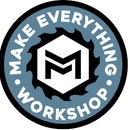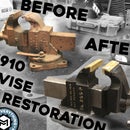Introduction: $25 Chainsaw Milling Attachement
In this video I go through the steps of making a "Alaskan style" chainsaw milling attachment.
Step 1: Making an Alaskan Style Chainsaw Milling Attachment
Materials:
12' - 1" x 1" (1/16" wall) Steel tube
4' - 2" x 2" x 1/4" steel bar
16" - 1.5" x 1.5" (1/8" wall) Steel tube
6 - 3/8" x 3" Bolts
4 - 3/8" Nuts
Total cost = About $25
I get my steel from a local metal supplier on Long Island, NY.
https://www.yellowpages.com/west-babylon-ny/mip/pu...
Safety Warning: PLEASE take the proper precautions when working with this material. Be sure to wear all the proper protection when welding and grinding. Wear safety glasses, ear protection, respiratory protection and gloves (When appropriate) when working in the shop. Always be aware of your surroundings when working with a chainsaw, it can and will hurt you.
Please note: You will notice in this video that the saw struggled to cut through the log. The attachment worked exactly as intended, but the chain I was using was not sharp, and not ground to the proper angle for ripping. If your going to try and mill large material like this, spend the extra time and money and get yourself the proper chain to avoid being totally exhausted at the end of each cut!
For photos and a detailed write up, see the following steps!
Step 2: Layout
I had done some research on milling bars before starting this project. I looked up several commercially available milling attachments and took the features I liked most for my own. I also saw several DIY milling attachments on google images that I used as inspiration.
The design of this is very simple. Its basically a frame that rides along the flat "reference side" of the log, and transfers that down to the saw bar cutting through the log. The thickness of the cut is adjustable. My bar is 36" long, so I sized the length of my attachment accordingly. This design would be scaled to fit any sized bar.
Step 3: Material Prep
After my initial sketch I began to cut up my material.
Using an 18v porta-band I cut the 1"x1" tubing to length, and using my LB1000 2x72 belt grinder I deburred everything.
Step 4: Frame Assembly
After prepping my material I laid out the rectangular frame and welded it all together.
Its essential that this frame is flat, this will ride along the log surface as you cut so any large weld bumps or areas where the material doesn't butt up well will cause disruption while your pushing your saw through the log.
Step 5: Adding the Guide Blocks
I purchased some 1.25" x 1.25" tubing that my 1x1 would fit inside without interference, and used those as guide blocks. I made these pieces 8" long so there would be less deflection inside them.
These pieces are critical to be welded square to the frame or it will warp your bar when you clamp everything down.
Step 6: Building the Bar Clamps
For the clamps that hold the attachment to the actual chainsaw bar I used 1/4" x 1.5" flat stock. The stock I used was leftover from another project so it was pretty rusty, but a little cleanup with the angle grinder made it weldable in just a few minutes.
These pieces are 8.5" long, and they have a small 2.5" spacer welded to them. The space keeps the clamps away from the chain when its all tightened down.
Step 7: Drilling the Clamp Bolt Holes
Once these pieces are all welded up I drilled holes to fit the 3/8" hardware I will be using to clamp the bar to the attachment.
Its important here to make sure the clamping pieces line up with each other. To do this, drill the 2 holes in your first clamp, then transfer those holes with a sharpie or transfer punch to the mating clamp. And label your clamp pairs do you keep them together.
I drill slightly oversized holes for the 3/8" hardware so I don't have to fight with it to assemble it every time.
Step 8: Attaching the Clamps to the Guide Bars
These two clamps will be welded to 1x1 tubing to act as the thickness guide bars.
These finished pieces will then go inside the oversized guide blocks that are welded to the frame.
Its essential that these clamps are welded square to the guide bars or it will cause your bar to warp when its all tightened up.
Step 9: Adding Hardware to the Guide Blocks
In order to keep your guide bars at a specific height while your milling you need hardware to clamp them in place.
I chose to weld 3/8" nuts to the guide blocks so I could run bolts that would pinch the guide bars at a specific height.
WARNING: DONT WELD ZINC COATED METAL INSIDE. I have a fume extractor and a fan running to dispose of the fumes and even that isn't good enough. If your going to weld plated hardware do it outside, or not at all. McMaster Carr sell non coated weldable nuts, buy some.
Step 10: Adding a Crossbar
At this point the milling attachment could be confirmed finished. I decided to add a crossbar between the guide blocks as both a handle and a support piece.
This bar was very helpful when using the attachment as a place to put your hand while pushing. It also kept the bar nice and stiff under the weight of the saw.
Step 11: Attaching to the Saw
Once your at this point its time to put it on your saw bar. Every bar is a little different and you'll have to mess around with yours to get it in the proper position. One thing I will note though is you have got to make the clamps on the bar TIGHT. If they are loose in any way the clamps will shift while milling causing your chain to hit the steel clamps which is NO GOOD.
Some people drill a hole in their bar and bolt through it to the attachment, I chose not to.
Step 12: Using Your Milling Attachment!
Now its time to make some sawdust!!!
I tried mine out on a but 26" oak log that has been sitting around for a few years.
You will need to attach a flat reference board to the log to make the first cut nice and flat. I used a 2x8 and bolted it into the log with big decking screws.
Step 13: Things to Consider
I hope this little write up was helpful to someone interested in building a milling attachment of their own. The video on the first step goes into slightly more detail on the build, so check that out as well. Here are some things to consider if you want to try this project:
1: Welding is dangerous, BE CAREFUL
2: Chainsaws are even more dangerous, BE EXTRA CAREFUL
3: Ripping/milling chains were made for a reason. We tried this out with a regular crosscut chain and it was a slow painful cut process. A week after I shot this video I got a ripping chain made for this application and the results were far better. It cost me about $45 dollars to replace the chain and was worth every penny.
4: SAFETY IS IMPORTANT: I have been working with tools my entire life and have developed a level of comfort and respect for their power and danger. I take risks in my shop that no one else should take. Please understand the risks that are involved with using saws, welders, grinders, and any shop equipment.
If you want to learn how to use equipment find a local fabricator, workshop, or maker space, show them you are interested to learn, and I would bet they would want to teach you. The handmade community in general is dying, and those of us who love and cherish these skills are usually eager to pass them on. If your in the NYC/Long Island area, check out my makerspace, and come learn how to make cool stuff.
www.makeeverythingshop.com













